Papers by Selliah Sivarajasingham

Journal of Economic and Administrative Sciences, Sep 21, 2021
PurposeThis study investigates the long-run relationship between workers' remittances and hum... more PurposeThis study investigates the long-run relationship between workers' remittances and human capital formation in Sri Lanka by using the macro-level time series data during the period of 1975–2020.Design/methodology/approachIn this study, the augmented Dickey–Fuller (ADF) and Philips–Perron (PP) unit root tests, the autoregressive distributed lag (ARDL) bounds cointegration technique, the Granger causality test, the forecast error variance decomposition technique and impulse response function analysis were employed as the analytical techniques.FindingsIn accordance with the results of unit root tests, the variables used in this study are mixed order. Results of cointegration confirm that workers' remittances in Sri Lanka have both long-run and short-run beneficial relationship with human capital formation. The Granger causality test results indicate that there is a two-way causal relationship between workers' remittances and human capital formation. The results of forecast error variance decomposition expose that innovation of workers' remittances contributes to the forecast error variance in human capital in bell shape. Further, the empirical evidence of impulse response function analysis reveals that a positive standard deviation shock to workers' remittances has an immediate significant positive impact on human capital formation in Sri Lanka for a period of up to ten years.Practical implicationsThis research provides insights into the workers' remittances in human capital formation in Sri Lanka. The findings of this study provides evidence that workers' remittances help to produce human capital formation.Originality/valueBy using the ARDL Bounds cointegration and other techniques in Sri Lanka, this study fills an important gap in academic literature.
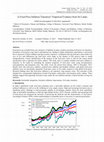
Asian Social Science, May 16, 2015
Food prices are excluded from core measures of inflation in many countries assuming food prices a... more Food prices are excluded from core measures of inflation in many countries assuming food prices are transitory. Exclusion of food prices may lead to information loss, leading to higher inflationary expectations, a downward bias to forecasts of future inflation and lags in policy responses. Assumption that log food price series behave by way of I(1) and differenced log food price series linger in the manner of I(0) process leads to model misspecification. Correct identification of the memory in the food price series is vital for the correct model specification and is important for policy makers. This study aims to examine whether food price inflation is transitory in Sri Lanka by estimating the memory properties of food price series using non-parametric, semi-parametric and parametric tests. The study covers the period from January, 2003 to December, 2013. Results show that food price inflation, nonfood price inflation and headline inflation, and global food price inflation series are fractionally integrated. Food price series in Sri Lanka commoves with global food prices. Research findings show that food price inflation is not transitory, long memory series. The outcomes of this attempt have consequential implications towards food policy, trade policy and monetary policy makers. These findings suggest that neglecting food prices may render the core inflation measure a biased measure of long run inflation.
International Journal of Social Economics, Oct 13, 2020
for excellent research assistance. The views expressed in this paper are those of the authors and... more for excellent research assistance. The views expressed in this paper are those of the authors and do not necessarily represent those of the Federal Reserve Bank of New York or the National Bank of Belgium. The views expressed herein are those of the authors and do not necessarily reflect the views of the National Bureau of Economic Research. NBER working papers are circulated for discussion and comment purposes. They have not been peerreviewed or been subject to the review by the NBER Board of Directors that accompanies official NBER publications.
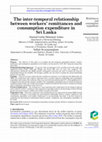
Journal of Economic and Administrative Sciences, Jul 30, 2020
Purpose-The objective of this study is to examine the inter-temporal relationship between workers... more Purpose-The objective of this study is to examine the inter-temporal relationship between workers' remittances and consumption expenditure in Sri Lanka over the period of 1975-2017 using the annual time series data. Design/methodology/approach-To test the order of integration of the variables used in this study, the augmented Dickey-Fuller (ADF) and Phillips and Perron (PP) unit root tests were employed. The autoregressive distributed lag (ARDL) bounds cointegration technique was used to examine the long-run relationship between the variables. The Granger causality test was used to examine the causal relationship between the variables. Findings-The unit root tests confirm that the variables are stationary at 1st difference I(1). Meanwhile, the ARDL test results show that workers' remittances have a positive long-run relationship with consumption expenditure in Sri Lanka. The coefficient of the error correction term indicates that 9.3% of disequilibrium error is adjusted each year and the response variable of the consumption expenditure moves towards the long-run equilibrium path. Further, the results of the Granger causality test indicate that workers' remittances Granger cause consumption expenditure in the short-run. Practical implications-The findings have some important policy implications for the design of efficient policy related to workers' remittances and consumption expenditure pattern, the knowledge of which will help promote the macroeconomic stability and welfare of people in Sri Lanka. Originality/value-This study contributes to the existing literature by using newly developed ARDL bounds cointegration techniques to investigate the inter-temporal relationship between workers' remittances and consumption expenditure in Sri Lanka. Furthermore, to our knowledge, this study is the first research in examining the inter-temporal relationship between workers' remittances and consumption expenditure in Sri Lanka.
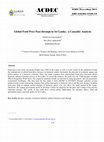
Food prices have been increasing sharply since 2003 in Sri Lanka as well as in the world. In the ... more Food prices have been increasing sharply since 2003 in Sri Lanka as well as in the world. In the globalized world, the transmission of global food price increases to domestic market determines the decision of economic agents and policy makers of a domestic economy. Thus, this study examines how international food price increases affects domestic inflation dynamic process in Sri Lanka. To assess this purpose, the study uses the VAR Granger causality /Block Exogeneity Wald Tests. The empirical statistical results are derived by using parametric and non-parametric econometric techniques. The data span for this study is from 2003M1 to 2013M12. Granger causality reveals unidirectional causal relationship running from global food price to domestic prices and the past changes of global food price help to explain current changes of domestic prices over and above the study period in Sri Lanka. Therefore, Sri Lankan government needs to develop a safety net program for the poor and a longer term poverty reduction strategy. The results of this study have various policy implications for monetary policy, food and agricultural policy and trade policy for Sri Lanka.
Proceedings of the International Conference on multidisciplinary Research, Dec 31, 2018

Sri Lankan Journal of Agricultural Economics, Dec 30, 2018
The relationship between inflation rate and inflation volatility has attracted more attention by ... more The relationship between inflation rate and inflation volatility has attracted more attention by theoretical and empirical macroeconomists. Empirical studies on the relationship between food inflation and food inflation variability is scarce in the literature. This study examines the intertemporal dynamic linkages between food price inflation and its volatility in the context of Sri Lanka. The empirical evidence derived from the monthly data for the period from 2003M1 to 2017M12 for Sri Lanka. Food price inflation is defined as log difference of food price series. The volatility of a food price inflation is measured by conditional variance generated by the FIGARCH model. Granger causality tests show that food inflation seems to exert positive impact on inflation variability. Hence, the findings of the study supports the Friedman hypothesis in both cases of consumer food price inflation and wholesale food price inflation. This implies that past information on food inflation can help improve the one-step-ahead prediction of food inflation variability but not vice versa. Our results have some important policy implications for the design of monetary policy, thereby promoting macroeconomic stability.
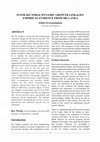
The Sri Lankan economy has been undergoing structural changes for the last few decades. The exist... more The Sri Lankan economy has been undergoing structural changes for the last few decades. The existence of dynamic linkages among the three major sectors-agriculture, industry and services of the Sri Lankan economy are examined in this paper for the period of 1960-2011. We employed graphical analysis including scatter plot, line graph, Confidence Ellipse and Nearest Neighbor fit to identify the basic features and the relationship between selected variables. The dynamic sectoral growth linkage results suggested the existence of inter-linkages across different sectors of the economy. ADF test and PP test were used to test the unit root characteristics of the time series variables. Inter temporal correlation results show that there exists a high positive statistically significant correlation between all sectors. Engel-Granger (EG) co-integration test provides further evidence for this. Error correction model estimates indicate that short run changes in Industry GDP have a positive impact on short run changes in Agriculture and services GDP. The results of Granger-causality test suggested that services growth causes agricultural and industrial growth significantly. The findings implied that by developing the services sectors, agricultural and industrial growth can be stimulated.
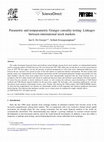
Physica D: Nonlinear Phenomena, Apr 1, 2008
This study investigates long-term linear and nonlinear causal linkages among eleven stock markets... more This study investigates long-term linear and nonlinear causal linkages among eleven stock markets, six industrialized markets and five emerging markets of SouthEast Asia. We cover the period 1987-2006, taking into account the onset of the Asian financial crisis of 1997. We first apply a test for the presence of general nonlinearity in vector time series. Substantial differences exist between the pre-and post-crisis period in terms of the total number of significant nonlinear relationships. We then examine both periods, using a new nonparametric test for Granger noncausality and the conventional parametric Granger noncausality test. One major finding is that the Asian stock markets have become more internationally integrated after the Asian financial crisis. An exception is the Sri Lankan market with almost no significant long-term linear and nonlinear causal linkages with other markets. To ensure that any causality is strictly nonlinear in nature, we also examine the nonlinear causal relationships of VAR filtered residuals and VAR filtered squared residuals for the post-crisis sample. We find quite a few remaining significant bi-and unidirectional causal nonlinear relationships in these series. Finally, after filtering the VAR-residuals with GARCH-BEKK models, we show that the nonparametric test statistics are substantially smaller in both magnitude and statistical significance than those before filtering. This indicates that nonlinear causality can, to a large extent, be explained by simple volatility effects.
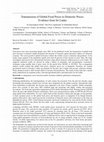
Asian Social Science, Apr 30, 2015
Food prices have been increasing sharply since 2003. In the globalized world, the transmission of... more Food prices have been increasing sharply since 2003. In the globalized world, the transmission of global food price increases to domestic market determines the decision of economic agents and policy makers of a domestic economy. The recent growth of global food prices affects the welfare of poor consumers and producers. In Sri Lanka, large segment of the population spends more than 50 percent of their income on food. Thus, this study investigates and assesses how international food price surge affects domestic inflation process in Sri Lanka. The empirical statistical results are derived by using a battery of parametric and non-parametric econometric techniques using monthly data of price series for the period from 2003M1 to 2013M12. The co-integration analysis results confirm that global food prices, domestic prices are co-integrated. Therefore, Sri Lankan government needs to develop a safety net program for the poor and a longer term poverty reduction strategy. Policy attention needs to shift towards efforts to increase food production. The results of this study have various policy implications for monetary policy, food and agricultural policy and trade policy for Sri Lanka.
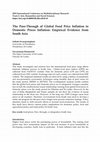
2018 International Conference on Multidisciplinary Research
This study investigates and assesses how the international food price surge affects domestic infl... more This study investigates and assesses how the international food price surge affects domestic inflation process in South Asia. Global food price indices (GFPI) are collected from FAOSTAT website. Data for domestic prices (CPI and CFPI) are collected from CEIC website. Exchange rates for each country are collected from IMF website. The empirical statistical results are derived by using a battery of parametric and non-parametric econometric techniques using monthly data of price series for the study period, 2005M1 to 2017M12. The co-integration analysis results confirm that the global food prices and domestic prices are co-integrated. Granger–causality test reveals the unidirectional causal relationship running from global food prices to domestic prices over the study period for Pakistan and Sri Lanka. However, In the case of India, Bangladesh and Nepal, samples do not show the evidence of causal relationship in the short run. However, in the long run, GFPI Granger cause local prices i...

There has been much concern in the relevant literature about the possible destructive economic ef... more There has been much concern in the relevant literature about the possible destructive economic effects of large military expenditures. It is supported by academics and scholars that defense expenditure can significantly affect a country’s economic growth and in some cases it influences external and internal debt. However, relevant empirical studies have produced contradictory evidence while the literature in this field remains relatively poor. Since independence, Sri Lanka has taken several steps to build up its economy in a successful way. At the same time, the country suffered nearly three decades of civil war and heavier defense burden during this time. Military expenditure was very low before the 1980s, but since then a need for foreign borrowing and external debt accumulation grew. Therefore, there should be a possibility relation between the deficits and foreign borrowing in Sri Lanka.
South Eastern University of Sri Lanka, Apr 19, 2011
The main purpose of this study to explore the main characteristics of stochastic behaviour of Sri... more The main purpose of this study to explore the main characteristics of stochastic behaviour of Sri Lankan exchange rate against to US dollar. The study used daily exchange rate time series, Sri Lankan exchange rate, (LKR/USS) and collected from Central Bank, Sri Lanka. The study period covers a time period from 2008 to 2010, which represents 722 trading days. The sample period was divided into two as
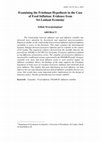
Sri Lankan Journal of Agricultural Economics, 2018
The relationship between inflation rate and inflation volatility has attracted more attention by ... more The relationship between inflation rate and inflation volatility has attracted more attention by theoretical and empirical macroeconomists. Empirical studies on the relationship between food inflation and food inflation variability is scarce in the literature. This study examines the intertemporal dynamic linkages between food price inflation and its volatility in the context of Sri Lanka. The empirical evidence derived from the monthly data for the period from 2003M1 to 2017M12 for Sri Lanka. Food price inflation is defined as log difference of food price series. The volatility of a food price inflation is measured by conditional variance generated by the FIGARCH model. Granger causality tests show that food inflation seems to exert positive impact on inflation variability. Hence, the findings of the study supports the Friedman hypothesis in both cases of consumer food price inflation and wholesale food price inflation. This implies that past information on food inflation can help improve the one-step-ahead prediction of food inflation variability but not vice versa. Our results have some important policy implications for the design of monetary policy, thereby promoting macroeconomic stability.











Uploads
Papers by Selliah Sivarajasingham